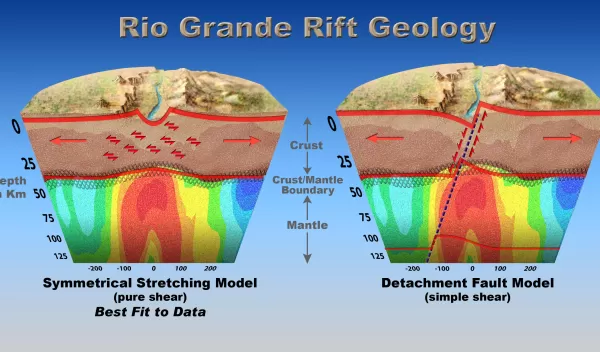
Deeper View Helps Explain Rio Grande Rift
Using a 600-mile line of sensors stretching across the desert Southwest, researchers have generated the most-detailed, subsurface map yet of a geologic fissure beneath the Rio Grande that reaches to 400 miles beneath the planet’s surface. The results help explain how tectonic forces have shaped the Rio Grande and its surrounding region over tens of millions of years, and provide scientists with clues as to how continental rifts evolve through time.
In an experiment dubbed “La RISTRA” (Colorado Plateau/Rio Grande Rift Seismic Transect) sensors that stretched from near Pecos, Texas, to the Four Corners area of Utah, detected earthquake-generated energy from around the world as the seismic waves passed through rock beneath the southwestern United States.
Seismic waves travel at different velocities, and the properties of the materials and structures the waves traverse influence their speed and features. By studying aspects of wave arrivals from earthquakes around the globe, the researchers were able to deduce information about the characteristics of the rock hundreds of miles below ground.
According to the researchers, the region has been gradually stretchingfor the past 30 million years, but, more so at the bottom of the measured area than at the top. Spread at the base of the crust is approximately four times that at the surface rift.
The researchers believe the new data may clarify alternate theories about how and why the rift formed, as stretching appears to be pulling the rift apart from below. Another theory suggests the rift was created when rock layers sheered apart.
The researchers reported their findings in the Feb. 24 issue of the journal Nature.
The research, supported by NSF, was conducted by scientists at the New Mexico Institute of Mining and Technology (NMIMT), Socorro; New Mexico State University (NMSU), Las Cruces; University of Texas, Austin; Los Alamos National Laboratory; and Arizona State University, Tempe.
Please see NMSU-NMIMT release at:
http://infohost.nmt.edu/mainpage/news/2005/23feb02.html
http://www.nmsu.edu/~ucomm/Releases/rio_grande_rift.html
NSF Media Contact: Josh Chamot, (703) 292-7730, jchamot@nsf.gov
NSF Program Contact: Robin Reichlin, (703) 292-8556, rreichli@nsf.gov
NMSU Media Contact: Karl Hill, University Communications, (505) 646-1885, khill@nmsu.edu
NM Tech Media Contact: George Zamora, Public Information Office, (505) 835-5617, gzamora@admin.nmt.edu
Research contact: Dr. Richard Aster, Earth and Environmental Science, (505) 835-5924, aster@ees.nmt.edu
Research contact: Dr. James Ni, Physics, (505) 646-1920, jni@nmsu.edu
NSF Awards:
EAR 9707190: http://www.nsf.gov/awardsearch/showAward.do?AwardNumber=9707190
EAR 9706094: http://www.nsf.gov/awardsearch/showAward.do?AwardNumber=9706094
Related URLs:
Rick Aster homepage: http://www.ees.nmt.edu/aster/
James Ni homepage: http://geophysics.nmsu.edu/jni/
